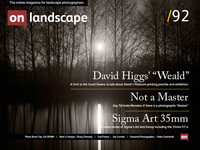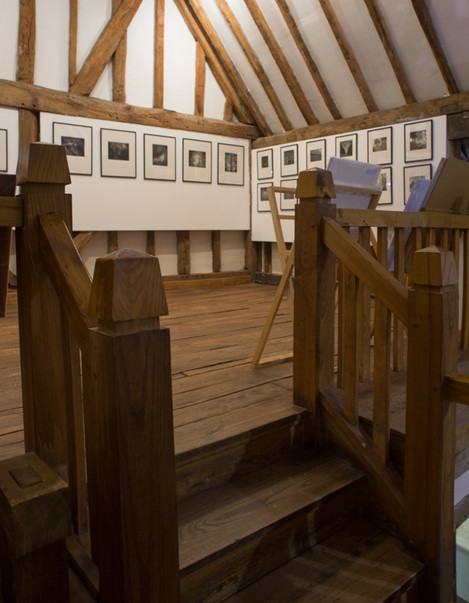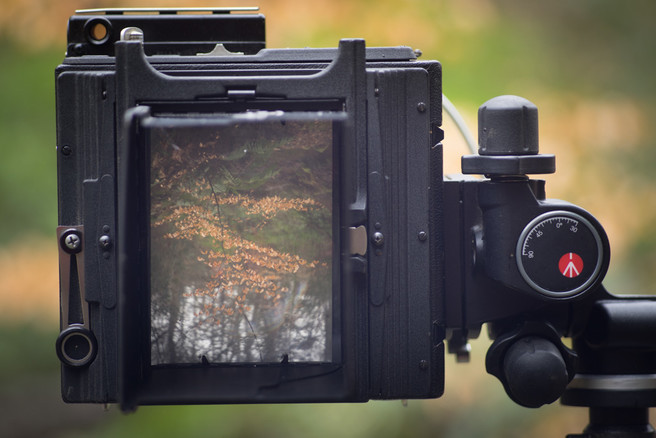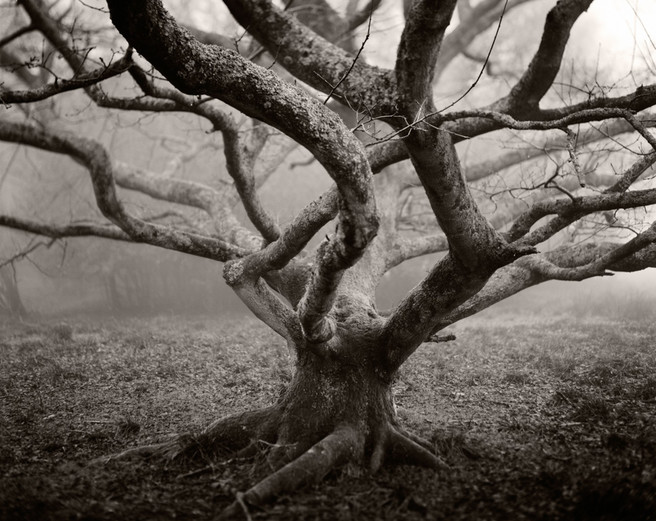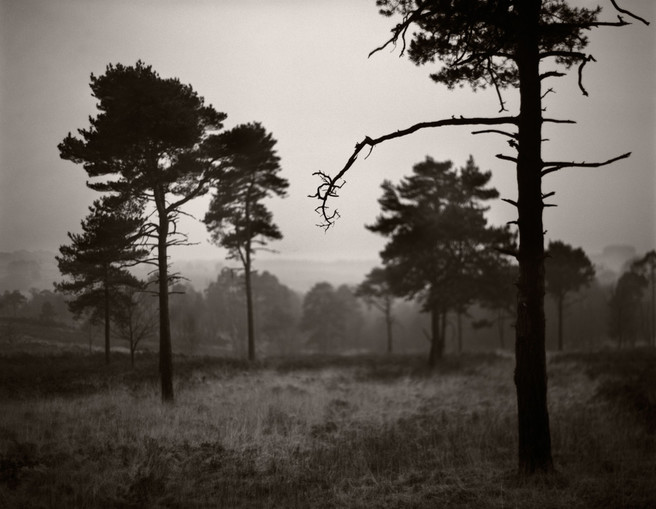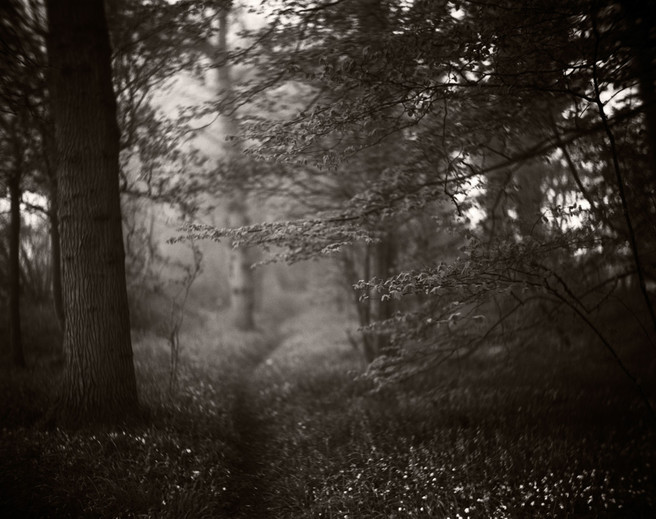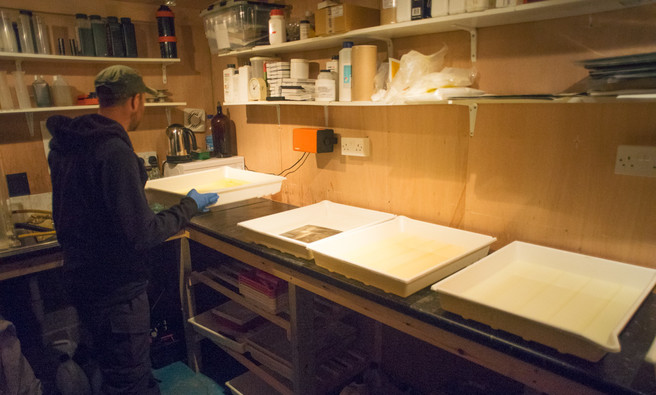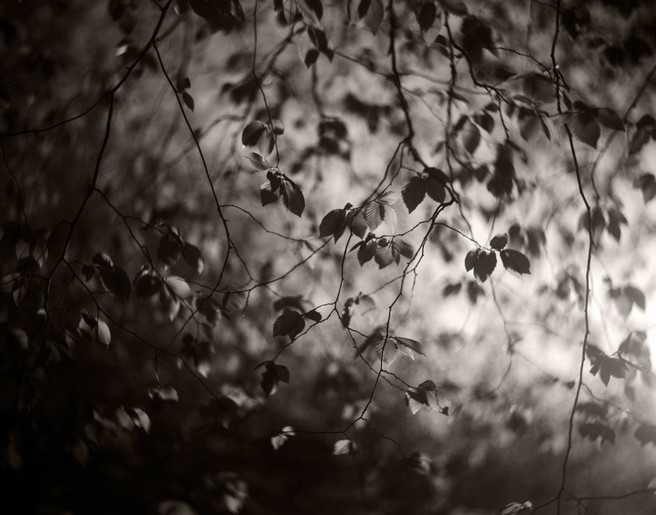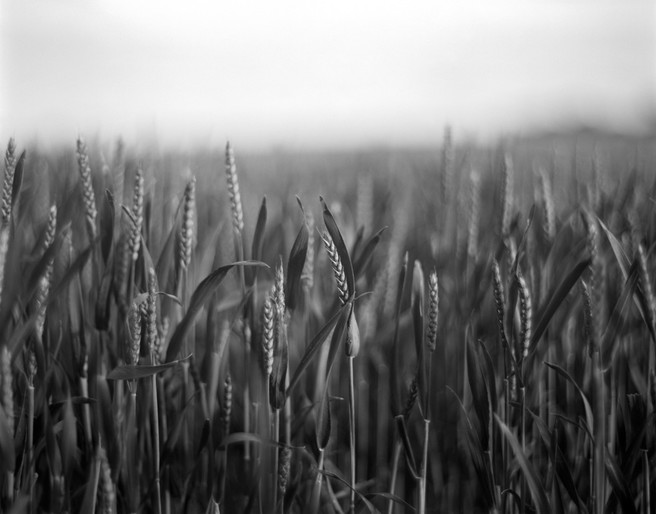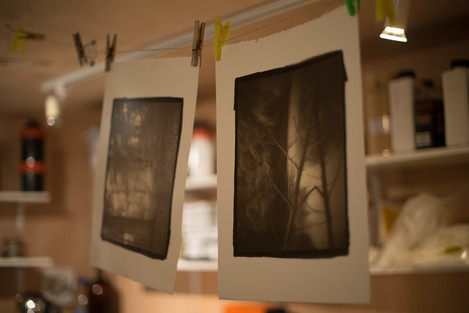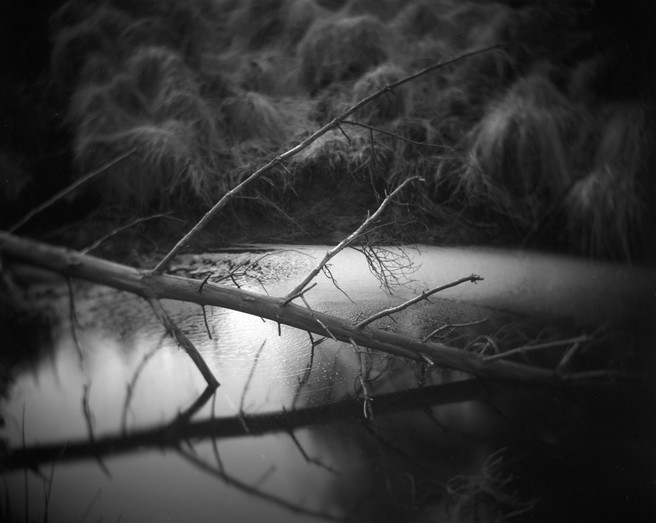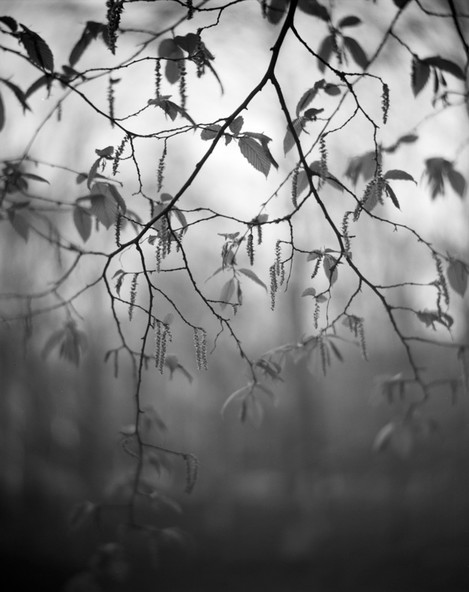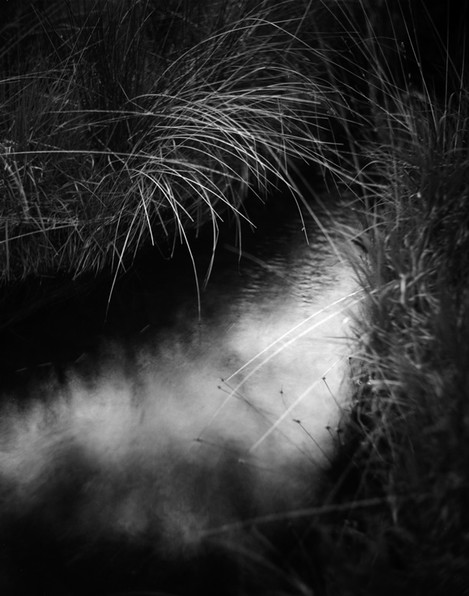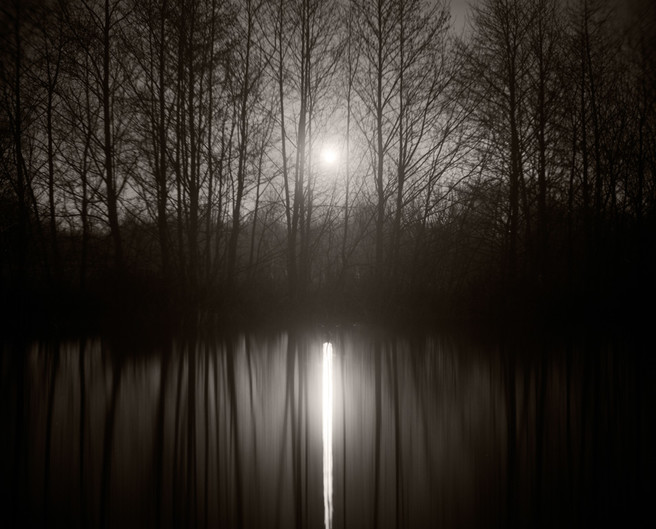A Journey into Platinum/Palladium

Tim Parkin
Amateur Photographer who plays with big cameras and film when in between digital photographs.

David Higgs
The following is a transcription of the screencast recorded after spending a day out with David wandering the Weald and waiting for the coated paper to dry for one of his platinum palladium prints.
Tim Parkin: Hi, we’re here with David Higgs, just spent the day in Ashdown Forest
David Higgs: Doing a lot of walking, chatting and not many taking pictures! That’s fine
TP: Nothing wrong with that, just great being out seeing the world. Also looked at the exhibition, The Weald, it’s final day!
DH: If you want to go and see it, its too late now!
TP: David will be making some prints for me later but right now we’re spending the next half an hour so going through some of your own personal favorites and some of mine too. You’ve been photographing for a fairly long time?
DH: Yes I have, different genres over time
TP: I came across your work as I scanned some of your 6x17’s a while a go
DH: Yes you did! Quite a while ago – 5 years I think!
TP: Since then you’ve started processing prints as platinum palladium
DH: That’s right. I moved to platinum about 4 years ago, I started doing alternate processes and dipped my feet into platinum before going full bore over the past 3 years really.
TP: I was asking earlier how you got into this, as you were already a film photographer and did a mix of black and white and colour. Mostly silver prints though?
DH: Yes. Then making my own inkjets over the years as well as technologies improved. I struggled to get the look I wanted from inkjets compared to platinum images I’d seen, mainly from historical images in museums
TP: Like the Victoria and Albert Museum?
DH: Yes V&A is a good source of old techniques. I was trying to get that, not that necessarily retro look but that tonal look. Where life isn’t black or white as it is with a silver print. There’s more control, definitely in the lower tones. It very gracefully dips into an acceptable black as you get with platinum prints.
TP: A very intense, dark grey?
DH: Yes!
TP: Where were you getting your photographic references for this from? Who would be the photographers you would be looking at thinking platinum palladium? Was it just the historical photographers? Julia Margaret Cameron?
DH: Yes, definitely. I think also I’d seen a few books by Sally Mann who obviously is known mostly for her wet plate colloidal work. She also had a couple of books where the platinum prints were made from the wet plate collodion negatives. They have got some beautiful warm brown tones, which was just what I was trying to get.
Before I did platinum (platinum / palladium – we’ll call it platinum, as everyone else does!), I was doing argyrotypes - which is a kind of a brown sienna type. Then I was toning them in selenium and that was getting pretty near to platinum.
I think it’s quite good to cut your teeth on a relatively cheap chemical before going into platinum as unfortunately it’s expensive and it’s very unpredictable in the contrast and tones that you get. A change in temperature or humidity in your dark room can make a big difference.
TP: I presume you were talking about the acidity of the paper or water - in terms of the acid / alkali balance?
DH: Yes they all have an effect and as much as you can try and counter those and accommodate those changes, happy accidents can occur!
TP: Do you run your dark room like lab conditions to get consistency?
DH: Even then it’s unpredictable!
TP: One print is not like an inkjet, you get the palladium plate and you do 4 or 5 test prints to get things right? Gives us an idea of a 8x10” palladium print cost wise
DH: Cost wise? It depends, on paper use and how many times you need to make a print. There’s one print in the gallery that I had to print 20 times to get the something I was happy to put up. That is the exception though, some of them are right first time.
Highlight areas are difficult because there are vagaries in paper so you get a change in contrast or you get some specks. It can be a cruel mistress to get an acceptable print. Sometimes it doesn’t go as you expect and then there are other times you get a different look and you think ‘actually quite like that, let’s get that again!’. There is an element of predictability and control over it
TP: The other aspect that comes in from your work is the use of lenses. You use a few normal-ish lenses but also lenses such as Tessars, Xenars, Ektars and are you using a large format camera? 5x4?
DH: It’s all in 5x4
TP: Your using mostly older lenses? That don’t have shutters, so it’s barrel lenses. The most common one people might have heard of are Petzval, which are old projection lenses
DH: That’s right. Old projection and camera lenses as well. They have a very unique lens signature and there’s a lot of curvature to the focal field. They are characteristically sharp in the centre and then blurry and swirly to the edges.
TP: They wander in and out of focus in interesting ways?
DH: My main subject matter is woodland, which is a very chaotic subject matter and your eyes are taking everything in, it’s a beautiful environment and as soon as you commit that to film or pixels you flatten everything. You lose that depth of field and perception that you have in the woodland. Your own pupil enlarges in woodland, and your own natural aperture increases, so you have less depth of field, and it’ a way of capturing that feeling in an image. Which is challenging. Nature isn’t as accommodating with compositions as you’d like! It’s a way of distilling elements of the woodland into something that gives you a feeling or an emotion, but the image is a flat image.
TP: These lenses are mostly Victorian or early 20th century, mainly used for portraiture. The Zeiss Jena Tessar is a lens I love because, and I saw it first in some of your pictures, which has a swirly character, which is the term.
Anyway, the first picture then,
DH: This is taken with a conventional lens, this is a Xenar. It’s the ‘junk lens’ that comes with the camera and taken on a Linhof. This particular tree is my favourite tree. Does everyone have one of those? I do! It changes over the years, bits fall off, bits grow. I was waiting for the right atmospheric conditions which was dense fog and it’s got a bit of back tilt on it so the plane of focus goes through the branches where they are just starting to cross
TP: The exhibition is call Weald, where does that come from?
DH: Weald is an Anglo Saxon term for impenetrable woodland and I live in the South East of England where the Weald is. It’s perceived as an urbanised part, and the most densely populated part, of the UK. Weald comes from a term for a place which is stretched from the south coast all the way up to where London is. The Roman’s had another name for it – The Forest of Anderida and they found it a challenge go get across because most of the land is clay, sandstone
TP: Slightly boggy as we found out!
DH: Quite boggy today. Didn’t take the right shoes did you! Lots of mud and clay. It’s amazing that in a months time it’ll be as hard as concrete.
TP: Ashdown Forest is part of the Weald then?
DH: Yes, it’s a large open access area, which we don’t have much of in the south east. We have The Downs as well, but for a wooded area it’s quite unique and relatively unknown. People know Ashdown Forest though A.A Milne and Piglet, and that lot. This photograph as made only 2 miles from Pooh Sticks Bridge! Eeyore’s gloomy place.
TP: You said you don’t see many people as they tend to congregate to Pooh Sticks Bridge or The car park. Are there many car parks?
DH: Yes if you like large format landscape photography then it’s ideally suited as they provide 30 different car parks so you’re only a mile from anywhere really. What’s unique is that people only walk 100 meters and then go back to their car. So we didn’t see anyone today, which is incredible, felt quite wild in places.
DH: This is a classic Ashdown Forest view with heathlands and Scots Pines and in the distances you have got part of The Downs and right on the right you can see Friends Clump, which was planted in Victorian times.
TP: Is that the area on the right?
DH: Yes that’s the famous kind of bit the forest as it sticks out and there’s a vista from there
TP: This is one of the things, which I was surprised about. It looks like Loch Tulla, it looks like the moorland of western Scotland. I noticed that you’ve got some swing on this picture as you can see the right hand side is in focus and the left hand side isn’t. Was that intentional? Built in camera swing?
DH: Bent camera you’d call it!
TP: That ‘Scottish’ look is the characteristic of the areas with Scot’s Pine but as we walked into the forest it changed dramatically.
DH: That’s one of the things about landscape photography in Britain, as there’s so much variety of different types of areas. Ashdown Forest particularly, there’s down land, heath land, conifer plantation forest as well as our ancient forest, which are the same as they were 2,000 years ago. So there’s a great variety in a relatively small space. Easily accessible by car or bicycle.
TP: We found quite a few of Victorian remains of grain mills and dams?
DH: Yes part of then industrial revolution happened here. The first blast furnaces in the UK were here, that’s because they had a ready source of wood to fire them and limestone is pretty nearby and that’s lots of evidence of iron ore. Most of the rivers do run blood red in Ashdown Forest.
TP: We’ll have a couple of pictures to show that, an incredible red.
DH: Almost unreal, un-natural polluted colours,
TP: Would have made Burtynsky quite happy
This was one of the first images of yours I saw of this type of character picture and this was taken with the Zeiss lens, from a Zeiss Miroflex camera. You got yours for a remarkable small sum! I had to buy the whole camera to get the lens and pay considerably more for it!
DH: £60 for a cloudy, chipped version but it works ok
TP: They have a sense of movement throughout the picture here this wasn’t windy was it? All the movement in the picture is the characteristics of the lens. I find that remarkable, the sense of three dimensionality it gives to the picture.
DH: Yes it does give it a three dimensional quality and also it means that as a photographer you can concentrate on part of the image and let everything else fall into place. If this image had been taken with a large depth of field and a nicely corrected left to right and centre, it would look a bit dull maybe and quite complex.
Whereas you can distill it down into it’s small components and simplify it to make it more understandable. There is a sense that the eye wanders around the image. I’m lucky enough that this is a two minute walk away. Where I live is heavily wooded and is lots of ancient woodland. This is actually an old droving road, this would have been the old road to Hailsham where the cattle market is. They would have run the cattle down this road. I only found this out a few days ago, but only till a few hundred years ago this was actually the road.
TP: These lenses don’t come with shutters. They are literally are a set of lens elements, possibly with an aperture, sometimes not. You use a 4x5 camera called a speed graphic which has a built in aperture though?
DH: It’s a lens at its most basic form really. I used the speed graphic camera because it’s got a focal plane shutter at the back, so I’m using these lenses either without an aperture or wide open. If you’re using wet place collodion or some extremely slow film or a ND filters, then you can bring it down to a quarter of a second or longer. All these were shot using PF4 which is a fantastic film in 5x4. Most of the images are a 30th or a 50th of a second.
TP: Difficult to do with a hat in front of the lens?
DH: Very difficult to do with a hat
TP: Yes, but the nice thing about the speed graphic is that you can put anything in front of it. You said you were putting old torch lenses in front of it and pinholes?
DH: Anything that looks like it could be a lens you can give it a go. It does encourage experimentation.
TP: They are not particularly expensive either?
DH: No, you can buy them from the UK, which are a bit more expensive, but there are hundred of thousands in the States. Pretty indestructible.
TP: They were the cheap press cameras in the day weren’t they?
DH: Yes, so people were photographing everything, portraits, reportage, sports. They come with sports finders (just a wire frame). Seems incredible, I only ever shoot on a tripod after careful consideration. These guys were firing off shots handheld.
TP: Is this what Weegee was using in the 1930’s. He was a news reporter and a crime scene photographer at one point. Fantastic stuff. All handheld, big explosive flash
DH: He’s got some fantastic pictures.
TP: This is another one that surprised me. It almost looks like it’s embroidery or doesn’t look real. William Morris perhaps? You were saying you wander around with the camera on the tripod, holding it up, like a view finder, because the characteristic of the lens is not what you see with the naked eye, it’s difficult to visualize.
DH: Yes I do. After a few years you get more of a hang of it. Something which may not on the surface appear so interesting may well work. Actually looking through the ground glass you can see a different world sometimes. I do think it reproduces not the kind of thing that we see with our eyes but what we see with our brain. It’s very clever at constructing what we are seeing. If you think of our eyes, they are a single meniscus lens and the centre of our vision is very sharp but our periphery is very blurry, but we scan when we’re looking at things and we put that together in our brain to make an image which makes sense to us. This is just distilling it down into what we would see if we concentrated on what we actually look at.
TP: You were saying that you photograph very often at dawn and dusk. Not for the golden hour light, but for a sense of calm?
DH: It’s a calm time of day, I have to say almost all my images are taken at dawn. Convenient time for me to take photos as well, with other commitments and family. There’s no-one else around and you’ve got the place to yourself. You’re waking up, the birds are waking up and the world’s waking up. Trying to capture that special quality to dawn light, it’s different to a sunset.
TP: The light is low, and as you say the eye opens up
DH: So you lose the depth of field and brightness. It’s all about dappled light
TP: There’s quite a few prints in your exhibition?
DH: There’s 51 prints, all in platinum, almost exclusively from 5x4, a little from medium format in there. All 10x8” prints.
TP: That’s quite a task I imagine. Did you know what you were letting yourself in for? Was it offered as an opportunity?
DH: Yes, it was offered as an opportunity. It was a 5 month exhibition in a great location, which was well lit and a good footfall. An opportunity for people to see these images. It was on two floors. I’d been to that gallery before and I’d forgotten how big it was! Then I realised there was a bit of pressure to get these prints done as I didn’t want to print bigger than 10x8” in platinum as that’s the sweet spot really. I like the way with 10x8” that when you’re looking at it, it can only be you looking at the image. It’s a singular thing. It’s a personal thing. That’s why I like printing that particular size, I can print bigger. Also the cost of platinum limits things. If it’s twice the size, it’s four times the volume.
TP: More opportunities for mistakes if it’s bigger?
DH: Oh yes!
TP: This is quite close to your house as well?
DH: If you photograph near home, it gives you more opportunities and that connect with the landscape. From a particular point, you know when the crops are coming in or when the leaves are coming out. There’s something special about home and the place you live, where you bring your children up. That connection is something that you don’t get if you go to Iceland, if you go on holiday.
TP: It would certainly be difficult to create a body of work like this from a few holidays in Iceland
DH: It’s five years to do these images and about five months of printing. Bit of a commitment, but very enjoyable
TP: Again, a great thing about this particular picture is that everyone has wandered past a wheat field like this. It’s a great example of how the lens you use and the process you use simplifies things.
DH: It’s a complex view, a field of wheat. You could use a macro lens and focus on one particular ear but you want that feeling that you’re in the wheat field.
TP: It’s like guiding the eye around the picture. It’s those central hotspots of the lens, which brings your eye to the centre
DH: These old lenses do tend to encourage a central composition rather the rule of thirds composition for sure. These images work well in monochrome in black and whites as they are about light and share, texture and tone.
TP: You say you print 10x8” but you shoot 5x4” negs. How do you go about printing?
DH: In the old days, you’d enlarge it through various stages on film. They don’t make that film any more so these are scanned images and printed on to clear inkjets, a clear material. Then contact printed.
TP: That process is quite peculiar, as you’ve shown me some of the negatives. Some which are strange blue or amber colours, some which almost look black and white. They don’t look like proper inverted pictures.
DH: That’s because you’re shining an ultraviolet light through it and the ferric oxalate that you use with the platinum is sensitive to ultraviolet light just that particular wave length and the inks block ultraviolet at different wavelengths and they block normal light. So when you look at the negative it’ll look a bit strange
TP: Dark ink might be more transparent to ultraviolet light than different ink
DH: Different colours have different effects as well.
TP: But you print these currently on an Epson 3880. Then did you make your own contact print for a UV?
DH: Well you can’t really buy these at the shops, so I’ve made a UV lightbox. You can use the sun but obviously you can’t print at night and you can only print on a couple of days of the year where I live. It’s a UV lighting system. It’s the insect-o-cuter lights that you get at the back of delicatessens and places like that. They attract the bugs and things.
TP: Do they do that in your dark room as well?
DH: Thankfully there aren’t too many bugs in my dark room! I made my own contact printing frame as well as you need to get the negative and the paper absolutely tight together as you can so they don’t blur
TP: There was a talented man called David Chow who was one of the experts in platinum palladium in the UK but he sadly died at the end of last year. You went on one of his courses
DH: I knew David and spent quite a bit of time with him honing skills and asking skills. We went to a few exhibitions together. He’ll be sadly missed
TP: He recommended the cone inks?
DH: The hardest parts in the process is the digital negative. Slapping some platinum on to paper, letting it dry and exposing it to an image isn’t too hard. The concentrations you can change and the contrast differences you can make, the humidity changes all have an influence on the image. Certainly the key is the digital negative and is the hardest thing to get right. You often have to print using a completely different technique based on the tones that you want to preserve in the image. I think each platinum printer has three or four different techniques for making a digital negative depending on the particular image they are printing. There’s always a work around, but I’m going to try John Cone’s Pigment prints (http://www.inkjetmall.com/) using carbon.
TP: There are different dilutions of carbon for all the different eight inks right?
DH: Much more like a silver negative
This is one of the ones I love from the top room of the exhibition.
DH: I think it looks better aS a print than on the screen
TP: It’s difficult to translate platinum palladium as it’s seems so much about the blacks.
DH: They are so delicate
TP: There’s a transition in the blacks which has to be seen in a print and the only time I’ve seen similar things is a on a John Blackmore workshop. You’re a fan of John Blackmore?
DH: He’s my nemesis. Every time I take an image that’s good, I think no-one has done that before. I then open a John Blackmore book and there is its!
TP: He had this excellent way of producing prints, which was about the darks and about the lights. High key and low key and that’s what has to be seen. If you can get an exhibitions go to see the Victoria and Albert museum or give Mr Higgs a ring and say can I pop round
DH: Museum of Photography at Bradford has a really good selection as well.
TP: You can go and book in to see the archive as well as it’s open
DH: They also did an exhibition at the Science Museum just before Christmas and that was one of the best exhibitions I’ve ever been to. It was from some of the first images ever made.
TP: It’s actually running at the Bradford Photography Museum now, Drawn By Light.
DH: It’s well worth a trip that is, it was fantastic
This is Hornbeam Keys taken last spring on a Petzval lens and that’s curved plane of focus. You can actually alter where you want the sharpness in the image, not just in the centre, depending on where you put things.
TP: You use camera movements as well on some lens. The Petzval lens doesn’t have much coverage so doesn’t give you much opportunity
DH: It’s not so good with movement, it’s not designed for 5x4 so you can see that it’s vignetting quite a bit which is a natural effect of the lens.
TP: The interesting thing about the Petzval is that they were never meant to cover 5x4 were they? Only meant to cover medium format or smaller?
DH: You would have had a credit card sized image from this particular lens (Carte de Visite). So they’d use the centre of the image circle
TP: You said you’ve dismantled your lens and found where it was from?
DH: Yes, it was a no name purchase from Ebay which his where I get most of my camera equipment of course! I took it apart becase back in the day they’d sign the lens and it was signed by Jamin who was an optician who made all sorts of lens. Camera lenses as well as optical lenses for spectacles back in 1849 in Paris
TP: You were saying that he trained Darlot and the Darlot Petzval was one of the famous lenses. So you had a lens from the guy who taught the master!
DH: We walked past this today
TP: Is this the brook near the dam?
DH: No this is near where you said it looked like Loch Tulla. It’s only seven or eight inches across. It’s taken with the Zeiss lens
TP: It’s nice and crisp but it fades in an out of focus beautifully.
DH: The light was particularly lovely on that ghyll
TP: Did you know what this lens was when you were buying it off Ebay? Did you know what it was going to do? A lucky find?
DH: I think it was a lucky find. It’s taken me a new direction with my photography. It’s expanded what I think of the world a bit really.
TP: The last photography in this series
DH: This is a new project I’ve got on for this year. I knew that photographically I did a huge amount last year. Quite a time commitment to print all these platinum images but I didn’t want to spend so much time away doing photography as I’ve got other commitment this year, the family is growing up and I really want to spend some time with them. So I wanted to concentrate on something that I could get to the old minute here and there. This is a pond, which is only half a mile away from my house. I found that a liberating experience just focusing on one subject that’s so near and have such a connection with and to see how much it changes day by day, it’s incredible. It’s just something that you’d walk past and not notice. This is an image I made with the wolf moon, you know those big moons that you get.
TP: The super moon they call it?
DH: This was damn cold as it was a January night and it’s about 11pm and the moon was just rising. There I was standing up to my knees in the pond thinking what am I doing here really, and hoping no-one notices!
TP: You said you had a secret technique to make the moon extend in the reflection?
DH: It’s about a 15-20 second exposure and what I notice was that when I was moving around to keep myself warm that the ripples when they came out from my wellies as they went across. When I first got there and it was still there were two moons. Obviously there was the moon in the sky and the moon in the water.
As I moved these ripples just went out and I thought with a long exposure that’s going to stretch everything. So I gave it a go.
TP: So you stamped up and down for the full exposure?
DH: Yes I did! Hoping no-one was watching
TP: A happy dance! Thank you for that we are going to show a few photographs on the website of your work and the exhibition. Any plans to exhibit elsewhere?
DH: This exhibition was my 14th exhibition in 5 years. So I’m a little exhibitioned out. If anyone’s out there and wants to show some of my work that would be great. For now, I’m going to concentrate on my project and concentrate on getting that just perfect platinum print. I’m getting close to what I would like to get to, but there’s still some way to go. Some time in the dark room and time concentrating on this project is what I have in mind for the next year
TP: Perhaps we could convince you into talking about these cones inks when you’ve got your head around them?
DH: Haven’t arrived yet, but once they have arrived then I’ll load them up and see what we’ve got.
TP: Thanks David
DH: Thanks Tim
We took a few pictures whilst down at David's - a great exhibition and a great photographer.
David Higgs was featured in a great video by Paul Mitchell's son, Angus - well worth watching (see below)
Don't forget to read the two other articles about David Higgs:
Platinum in Genesis- A Look at Platinum vs Inkjet via Salgado's Genesis Project
Weald – David Higgs- An Exhibition Review by Paul Mitchell
[youtube="https://youtu.be/zkYaGiY-Ecg"]

